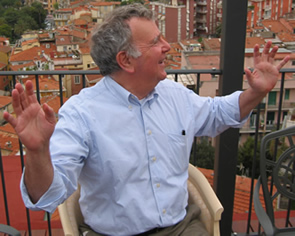Day 10: Bologna
The breakfast room at the hotel is very attractive–a freestanding building in the garden with lots of windows–and the breakfast is also very good.
Our first stop in the center of town is the very large Basilica of San Petronio, the patron saint of Bologna, which is set on one side of the Piazza Maggiore. Supposedly the Bolognese had plans to expand the building and make it bigger than St. Peter’s in Rome but the Pope disapproved and instead built a building for the university next door that made it impossible for the Bolognese to complete their plans. The building is very distinctive because they never finished the marble on the facade–probably because they ran out of money (or because they were miffed at the Pope)–so the bottom is covered in striped marble and the top is unfinished rough brick.

The inside of the church is relatively light and airy. There is a long meridian on the floor placed there in 1665 that traces the progress of the sun depending on where the shadow is cast along its length.



There is one very distinctive painting–a Last Judgement which has a particularly nasty two mouthed devil devouring two men–Brutus and Judas ??–at the same time.

We make a quick circuit around the market and admire the produce being displayed for sale.


We stop at a chocolate store and buy some very delicious (and very expensive) chocolate.

The Museo Ebraico is not far away and we spend about an hour in the museum. They have set up a very interesting permanent display that includes explanations about the history of the Jewish people and the Jewish experience in Bologna and Emilia-Romagna. The displays include large text posters and pictures (in Italian and English) as well as computer displays of additional information in Italian only. There are also very well produced and informative films in each of the six rooms that play continuously and alternate the English and Italian soundtrack.

Emilia-Romagna was relatively hospitable to the Jews since they first arrived in the 13th century and there was a Jewish presence in 37 communities in the region. The community in Bologna now numbers about 200 and, although there is a synagogue, we were told that it was not open for visiting.
The web site of the Museo Ebraico is also very informative and provides a lot of the information that is displayed in the museum.
As we walked in the Ghetto, we heard Jewish music in the air. It was being played through speakers mounted on the sides of buildings. This is part of a local project called Bologna risuona, where music appropriate to certain neighborhoods is played continuously to reflect some of the different cultures that were a part of Bologna’s history.


Lunch is at a famous old Bologna restaurant called da Gianni. The clientele is a mixture of tourists and local businessmen; the gentleman at the table next to us was a regular, didn’t even have to order, had his osso buco with polenta and wine brought immediately and was finished in about 20 minutes. The food was excellent…we shared a plate of salumi and prosciutto–mortadella at its source is exceptionally delicious–and the pastas were also terrific–tagliolini with prosciutto crudo for Diana and tagliatelle with meat sauce (ragu) for me. With a half bottle of Sangiovese, we were very satisfied.
After lunch, Diana rested in the hotel room and I went out exploring. I found the nearest laundromat and walked through some unexplored neighborhoods and saw some more churches, like San Francesco.

All over Bologna the streets are covered with porticos…some simple, some grand….which–in addition to providing shelter from the rain and sun–enabled the Bolognese to add additional living space to buildings above the porticos.


We’d always heard that Bologna was an exceptionally “civilized” place - the home of the university founded in the 11th century and still full of students and their energy, the elegant buildings, the extensive porticos, the wonderful food - and in this visit, we certainly are very taken with the city.
We are having dinner with Nancy Harmon Jenkins who is in Bologna finishing up research for an article on Bolognese ragu. We meet her at her hotel for a drink, meet her friend Paolo Lima–who is in the truffle business–and take a cab to Antica Trattoria da Gigina, a well-known Bologna trattoria famous for its ragu. Dinner is a lot of fun, although the famous ragu doesn’t live up to its reputation.
It is late by the time we take a cab back into the city, say goodnight to Nancy and Paolo and get back to the hotel. Tomorrow we will explore more of Bologna, which has quickly vaulted to the top of our list of favorite Italian cities.


0 Comments:
Post a Comment
<< Home